Prepared by “the Western Carolina University Program for the Study of Developed Shorelines July 1, 2019
Executive Summary
This study is the first of several case studies to be released by the Program for the Study of Developed Shorelines examining the feasibility and economics of targeted acquisition strategies in oceanfront, resort communities. Buyouts of vulnerable properties have become an increasingly popular tool for reducing future exposure in flood-prone communities across the U.S. However, proactive, targeted buyouts have not been common with oceanfront, investment (largely) properties despite the fact that these properties represent the “first line” of tropical storm exposure on the U.S. East and Gulf Coasts.
Our approach is to first examine the exposure of properties on North Topsail Beach, North Carolina to coastal hazards using a Vulnerability Assessment Protocol developed for examining infrastructure vulnerability in the National Park Service. The most exposed properties are identified and a coherent, contiguous group are selected for a fiscal analysis regarding a buyout’s costs and impacts. The analysis of costs includes purchasing the properties, removal costs, and lost tax revenues. The quantifiable benefits include reduced expenditures for coastal protection, engineering design/permitting, and maintenance.
For North Topsail Beach, North Carolina, the costs ($54.8 million with inflation) and benefits ($57.6 million) represent a savings of at least $2.8 million over 30 years. We have used a very conservative approach to estimating the costs. We assume that owners will receive full, assessed value for their property and that all properties will be fully viable for 30 years (given the exposure to storms and hazards of the target area, this is highly unlikely even with coastal protection). Finally, we assume that the properties will appreciate in value over the time period, again, a generous assumption.
The fiscal analysis does not include many unquantifiable benefits from the proposed targeted acquisition. These include the transfer of amenity value to other properties, reduced emergency management costs for the municipality, reduced need for consulting engineering fees, improved beach access for all residents and renters, and, quite frankly, no more ugly sand bags and a return of a recreational beach that all residents and guests can enjoy.
The best argument for the proposal may be this: wouldn’t it be nice if a municipality like NTB could stop spending all of their time, energy, administrative hours, and money on 7% of the tax base (the at-risk properties examined in this report) and turn all of those resources loose on the 93% of the tax base that will be much more sustainable over the next 30 years? Slightly changing the map of this community with a targeted acquisition would not mean the end to a prosperous beach town. Far from it. This proposal is a plan for strengthening the vast majority of the tax base for the long run.
Our goal for this series of reports is philosophical as much as practical. Invariably, buyout plans in oceanfront communities are viewed as too costly or impractical to be seriously considered. It is typical for the alternatives analysis in a storm protection EIS to dismiss the idea of targeted acquisitions in a paragraph or two. We hope that coastal communities will give more serious consideration to these buyouts as a beneficial management tool, and we hope that these case studies will spur meaningful discussions.
This proposal represents a first cut at how one might approach a scientific and fiscal analysis of targeted acquisitions for one such community — North Topsail Beach, North Carolina. The analysis shows that, in this case, the quantifiable benefits and costs result in a savings over the next 30 years. If outside funds (state or federal) are available for the buyout, then it becomes a very attractive prospect for the municipality. Even if outside funds are not available, the project would have significant benefits and is worth serious consideration. There are many unquantifiable benefits to these targeted acquisitions; however, the real benefit will be a chance to ensure the longer-term economic vitality of the more sustainable portions of the community. This is a way to strengthen North Topsail Beach, not diminish it.
Introduction & Purpose
Coastal communities across the country are facing the combined threats of erosion, storm impacts, and rising sea level. Over the next few decades, these processes are not likely to be existential threats to the existence of most barrier island communities, but they will present serious management challenges that will require the consideration of new ideas to protect the economic vitality of those coastal municipalities.
Most coastal properties are reasonably set back (from the ocean) or at high enough elevation to have a relatively low exposure and vulnerability to hazards. However, every community has well-known erosion hotspots and locations of repeat storm damage, where emergency managers gather as soon as the wind starts blowing. These highly exposed locations tend to utilize a disproportionate amount of time and money, forcing towns to balance the protection of a relatively small number of private properties against budget constraints, preserving the beach, and providing public access.
Traditionally, municipalities have dealt with problem areas through standard approaches to shoreline stabilization, including: 1) beach nourishment, 2) seawalls and bulkheads, 3) sandbags, and 4) groins. All of these approaches are costly and have environmental impacts. For small shorefront communities, the continued costs of shoreline protection may become prohibitive as sea level rises and all coastal hazards increase with time.
To effectively (and equitably) manage the distribution of municipal resources, oceanfront communities need to implement policies that are innovative, sustainable, and fiscally-sound. This means that, in the future, the footprint of a barrier island town may need to be modified to adjust to long-term changes in shoreline position and hazards. A shoreline management strategy is needed that stresses coastal resiliency by addressing community-wide economic and resource concerns, including the targeted, proactive removal (through a variety of mechanisms) of infrastructure highly exposed to coastal hazards.
Adopting sound coastal resiliency policies should include the planned removal of properties whose protection is requiring an inordinate amount of time (public officials) and money (typically public funds). Examples of buyouts and relocation of properties from flood-prone areas are plentiful across the country; yet, there is an exception. There are few examples of planned, pre-disaster removal of problematic properties from oceanfront, resort communities.
The Program for the Study of Developed Shorelines (PSDS) at Western Carolina University examined the efficacy of an acquisition-based approach in North Topsail Beach (NTB), North Carolina by: 1) assessing the exposure of parcels in NTB to coastal hazards (storm surge, inlet migration, flooding, and erosion); 2) selecting and refining parcels for inclusion in final target areas; and 3) evaluating the potential fiscal impacts (benefits and costs) of a strategy that removes highly exposed properties at NTB.
The goal of this analysis is to demonstrate that targeted acquisitions (buyouts) can be a viable option for a coastal municipality and not necessarily detrimental to its economy. To be clear, we have not engaged stakeholders in the process at this point. This document is a starting point for a conversation — a demonstration of an approach.
North Topsail Beach, An Overview
Topsail Island is a North Carolina (NC) barrier island located midway between Cape Lookout and Cape Fear on Onslow Bight (Figure 1). The island is oriented southwest-northeast, approximately 26 miles long, and bounded by New River Inlet to the northeast and New Topsail Inlet to the southwest. Topsail Island is comprised of three municipalities: Topsail Beach, Surf City, and North Topsail Beach (NTB). Barrier islands like Topsail are dynamic coastal environments, constantly being reshaped by the movement of sand by wind and wave activity.
NTB has a long history of coastal hazard impacts, including storms, flooding, erosion, and inlet channel migration. In recent decades, NTB has been impacted by numerous storms including: Fran (1996), Bonnie (1998), Irene (2011), and Florence (2018). Hurricane Fran (1996) was particularly destructive for NTB, flooding most of the town, breaching the island in several locations (Figure 2), and damaging three quarters of the homes on Topsail Island (Hibbs, 2016). The northeast end of NTB has also had continual issues with shoreline erosion and inlet channel migration, resulting in multiple episodes of beach nourishment (PSDS, 2018) and the installation of a continuous, geotextile sandbag revetment along 2,300 feet of shoreline.
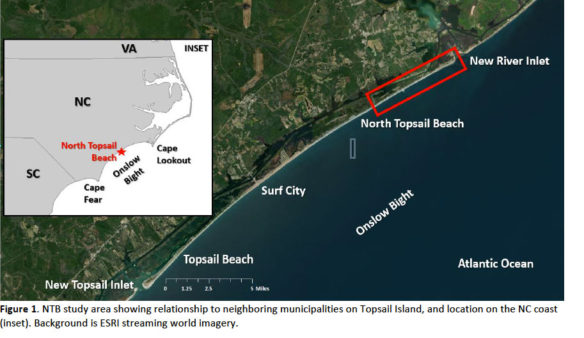
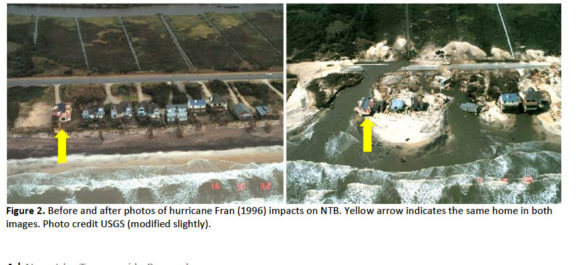
NTB Coastal Hazard Exposure Assessment
The first step in developing a plan for targeted buyouts from a portion of any community is to identify those properties that are at greatest exposure to coastal hazards. In some communities, this may be a small cluster of properties in an erosion hot spot (e.g. South Nags Head, NC) or a cluster of homes that were constructed too far seaward (e.g. Folly Beach, South Carolina). In some communities, there are larger stretches of high exposure properties that have been causing management problems for decades. This is typical along downdrift, inlet shorelines. NTB fits into this last category.
The approach for assessing the coastal hazard exposure for NTB has been adapted from a vulnerability assessment protocol that the authors developed for the National Park Service. This protocol has already been applied successfully in NC at Cape Hatteras and Cape Lookout national seashores.
The coastal hazards analyzed as part of the exposure assessment for NTB include: 1) storm surge, 2) inlet migration, 3) flooding, and 4) oceanfront erosion. NTB parcel data was obtained from the county (Onslow County GIS, 2019) and analyzed in a Geographic Information System (GIS) using hazard data obtained from county, state, and federal agencies (Table 1).
This coastal hazard assessment focuses on parcels within NTB from the west boundary of Coastal Barrier Resource System (CBRS) Unit L06, northeast to New River Inlet. In addition to parcels within CBRS Unit L06 on NTB, the parcels within two small non-CBRS land areas at the northeast end of the island are also included for continuity (Figure 3).
This initial study area includes 2,525 parcels comprising over 2,886 acres. These parcels include empty lots, lots with single family homes and duplexes, and multi-family dwellings where each parcel is an individual unit within the multifamily structure. Parcels with the highest coastal hazard exposure were determined by analyzing which parcels have at least 50% land area within each hazard layer. The basic steps of this analysis are discussed in this section.

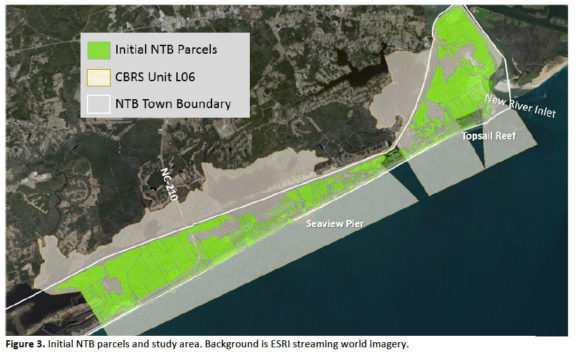
Step 1. NTB Storm Surge Exposure Analysis NOAA storm surge hazard maps (NOAA NHC, 2018) were utilized for the storm surge exposure analysis. These maps are based on the hydrodynamic Sea, Lake, and Overland Surges from Hurricanes (SLOSH) model, which simulates storm surge from tropical cyclones. Using GIS, the raster data for a category 2 storm were converted to inundation polygons. No further analysis was necessary as all parcels within the NTB study area showed inundation with a category 2 storm (Table 2, Figure 4A). Many of these properties are also flooded during king tides.
Step 2. NTB Inlet Hazard Exposure Analysis The NC Department of Environment Quality (DEQ) Division of Coastal Management (DCM) proposed (draft) inlet hazard area (IHA) was utilized for the inlet migration exposure analysis. The initial NTB parcels were clipped to the extent of the proposed IHA, and the area of each clipped parcel was compared to the original total parcel area. Each parcel that contained over 50% of land area within the IHA were used as a baseline in Step 3. Results from this portion of the analysis indicate 556 parcels (approximately 73 acres) are over 50% within the IHA (Table 2, Figure 4B).
Step 3. NTB Flood Hazard Analysis FEMA flood hazard zone data (Special Flood Hazard Area – VE Zone; FEMA, 2019) were utilized for the flooding exposure analysis. The FEMA VE zone is defined as areas subject to a 1-percent-annual-chance flood event, with additional hazards due to storm-induced velocity wave action. The IHA baseline parcels (from Step 2) were clipped to the extent of the FEMA VE zone, and the area of each clipped parcel was compared to the original total parcel area. Each parcel that contained over 50% of land area within the FEMA VE were used as a baseline in Step 4. Results of this step indicate that 367 parcels (approximately 57 acres) of the 556 from Step 2 are over 50% within FEMA VE (Table 2, Figure 5A).
Step 4. NTB Coastal Erosion Exposure NC oceanfront erosion rates (NC DEQ DCM, 2017) were utilized for the coastal erosion exposure analysis. In addition, recent aerial imagery (2016) was used to digitize an oceanfront vegetation/sand bag line. The erosion rates were used to segment and buffer the digitized vegetation/sand bag line into generalized sections: less than 4 feet/year erosion – 60-foot buffer; 4 to 6 feet/year erosion – 120-foot buffer, 6 to 8 feet/year erosion – 180-foot buffer, and greater 8 feet/year erosion – 240-foot buffer. These buffer zones were then utilized as a basis for a final erosion hazard zone (Figure 5B).
The FEMA VE baseline parcels (from Step 3) were clipped to the extent of the erosion hazard zone, and the area of each clipped parcel was compared to the original total parcel area. Each parcel that contained over 50% of land area within the erosion hazard zone were then exported as a final result. Results of this step indicate that 290 parcels (approximately 42 acres) of the 367 from step 3 are over 50% within erosion hazard zone (Table 2, Figure 5B)
NTB Final Results: Highest Exposure Parcels This multi-step process (a conservative approach) assessed the exposure of NTB parcels to major coastal hazards (storm surge, inlet migration, flooding, and erosion). At each step, the parcels with at least 50% land area within the hazard zone were selected; these parcels then served as a baseline for the analysis of the subsequent exposure hazard. Final results of this assessment demonstrate 290 parcels at NTB (approximately 42 acres) have the highest exposure to all hazards: storm surge, inlet migration, flooding, and erosion (Figure 6).
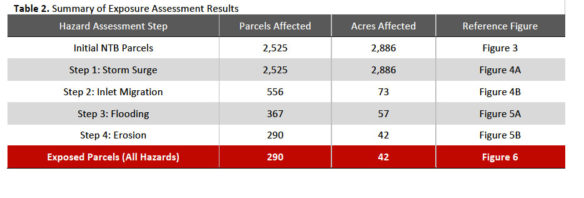
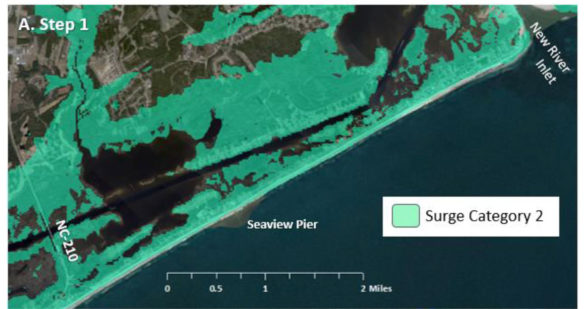
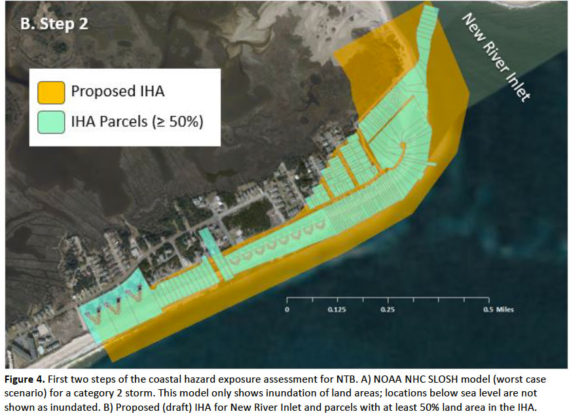
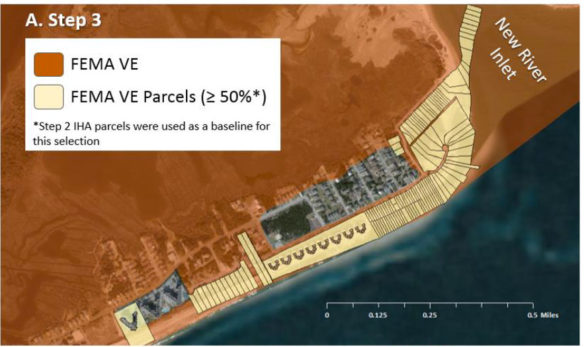
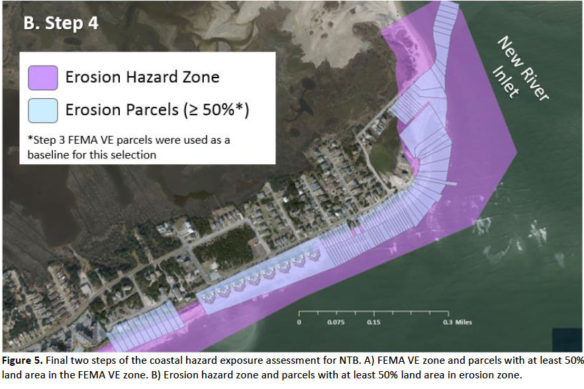

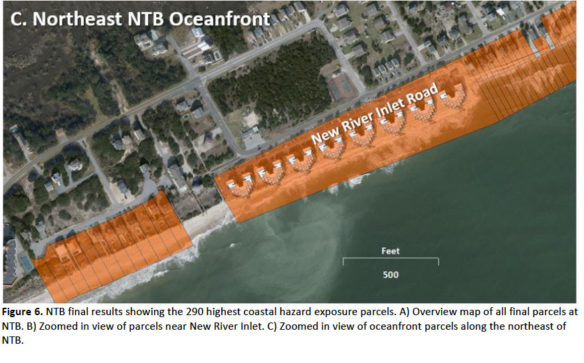
Background: Targeted Acquisitions
“Targeted acquisitions” refers to the buyout or purchase (typically by a governmental entity) of privately-owned property exposed to coastal hazards with the goal of reducing and/or preventing repeated storm-related property damage and associated public expenditures. After acquisition, existing structures are demolished or relocated, and no additional permanent structures are built (other than dune walk/cross-overs and public amenities such as showers and restrooms). Purchased properties remain in public ownership in perpetuity. Although a targeted acquisition policy can be a complex undertaking, it represents a sustainable way to proactively reduce the social, environmental, and economic costs associated with vulnerable coastal property.
This proposal for NTB examines the viability of targeted acquisitions as an option for an oceanfront community with perpetual coastal hazard issues. A major difficulty in considering buyouts as a coastal management tool for most communities is the lack of any analysis of the costs vs. benefits. Without such analyses, communities may perceive acquisitions as cost prohibitive. For NTB, this report will provide valuable information for all residents and property owners as they consider future coastal management options for the challenging north end.
Goals & Benefits
In recent years, beach nourishment has become a preferred approach for protecting coastal development. During a presentation at the Beach Nourishment Workshop in 2010 (Onslow County and Town of North Topsail Beach, 2010), NTB Town officials provided the following reasons for investing tax dollars for beach nourishment:
1. Preserving tax base and promoting future growth,
2. Sustaining local tourist economy and jobs,
3. Preserving an outstanding local recreation asset that attracts visitors nation-wide, and
4. Promoting public safety and public/private property protection.
Targeted acquisitions, as an integrated component of a local shoreline management policy/plan, will achieve the above objectives, while accomplishing a number of additional goals:
1. Protecting Coastal Resources and Habitats. Buyouts protect barrier beaches that serve as the basis for coastal economies and support natural littoral processes (e.g., shoreline, dune, and inlet migration, overwash).
2. Minimizing Property Damage. Targeted acquisitions permanently eliminate the potential for damage to select, problem coastal properties and the resulting federal, state, and local capital expenditures.
3. Maximizing the Value of Nearby Coastal Property. Buyouts may remove some properties from the local tax base, but that value is transferred to other properties in the municipality in a variety of ways: 1) enhancing the most important economic resource in the community, a natural recreational beach, 2) removing structures that impinge on the beach and prevent public use and egress, 3) allowing town resources to focus on the long-term protection of the more sustainable portions of the community.
Costs of Targeted Acquisitions
Two common concerns regarding buyouts are the anticipated high cost and the identification of a funding source for the purchase. As with any policy decision, there are costs of implementation (i.e., program costs) and the “cost” of lost revenues from the properties that are removed.
Land and capital are the primary contributors to local government revenue and community wealth through the generation of taxes, payroll, income, and services. Because acquisitions result in the permanent removal of private property from the local tax base, the loss of land and capital under a targeted buyout strategy is the primary fiscal impact to the locality.
Capital Costs of Property Acquisition
Identifying the governmental programs and public funding sources used to purchase private property is a critical aspect of any buyout strategy. Funding is most likely to come from multiple government sources, and capital costs will be dictated by the scope of the initiative, as well as the manner in which properties are acquired (e.g., purchased at pre- or post-storm value, and willingness of property owners to sell). While this study does not identify specific funding opportunities, it assumes that the capital costs of a targeted buyout strategy in NTB will be implemented with some combination of public funds. This study has not identified a recommended source of funds for a NTB buyout.
While specific funding levels and sources are best identified by local stakeholders during planning and development, earlier buyout efforts can be instructional for an assessment of the impacts of targeted acquisitions. In NTB in 2009, for example, 17 duplex structures with a total assessed value of over $17 million at the north end of NTB were imminently threatened and declared uninhabitable due to the loss of water, sewer, and electrical connections. Two of these duplexes were relocated to other parts of NTB at the expense of the property owners, while six were demolished at a cost to the town of $2 million. The other nine structures were eventually demolished, although the cost, or who paid, are not currently known.
The Concept of “Double Dipping“ or the Creation of a Moral Hazard
Government (federal, state and local) funding of coastal protection and disaster recovery promotes and maintains risky development, but also artificially increases the values of high-risk properties. Flood insurance, construction of flood control measures (e.g. beach nourishment), and disaster relief minimize, and in some cases, may even eliminate, property owner’s perceptions of risk. Land markets then capitalize on these government subsidies and risk perceptions, resulting in property values that fail to accurately reflect the real risks of ownership. These artificially enhanced values result in a form of “double dipping” by landowners who benefit from past governmental actions to support property value in addition to whatever value the landowner may have created through individual actions.
Such double-dipping can dramatically increase government costs of coastal management in general, and targeted acquisitions in particular, by requiring payments both for past management responses/strategies AND the costs of correcting those past mistakes through property acquisition. Absent government investments in storm damage mitigation and risk allocation mechanisms, it is likely that these property values would be substantially reduced. As a result, the incentives created by government responses to coastal hazards should be considered when a buyout plan is being formulated. In NTB, the costs of holding the shoreline in place in front of vulnerable, oceanfront properties have been borne largely by a combination of the town and property-owners.
Using Tax Revenue to Assess Fiscal Impacts of Buyouts
Because targeted acquisitions result in the public purchase and ownership of privately-owned property, the primary concern among many local coastal communities is the expectation of a meaningful decrease in the local tax base. Examining only the appraised value of the target properties to measure the impacts of buyout provides an incomplete assessment of actual impacts.
While estimating the initial cost of the acquisition of private property may be based on assessed value (as a proxy for market value), a more accurate way to assess the long-term economic impacts is to quantify losses in property, sales, and occupancy (if rented) tax revenue that might result from permanently removing high-exposure coastal properties from the tax base. Similarly, the public costs and benefits of protecting private development along dynamic shorelines through artificial stabilization can also be quantified through an accounting of public expenditures made for such efforts, as well as any associated increase or reduction in tax revenue. Estimates of future anticipated costs, while more challenging to identify, are achievable using accurate discount and price appreciation rates, scientific research, common sense, and realistic expectations.
Targeted Buyouts in NTB: A Fiscal Assessment
Final results of the Coastal Hazard Exposure Assessment (above) demonstrate 290 parcels (properties) at NTB (approximately 42 acres) that have the highest exposure to coastal hazards (storm surge, inlet migration, flooding, and erosion). These properties delineate a preliminary area for targeted buyouts. Further analysis of the preliminary results identified an additional 57 properties that should be included in order to create a contiguous and practical implementation area. It would be impractical to maintain utilities for only a few remaining homes or to manage a beachfront with scattered development. With this addition, a total of 347 NTB properties now comprise the final target area for strategic buyouts (Figure 7).
This fiscal assessment considers and compares the costs and the benefits (savings) of targeted acquisitions. Costs evaluated include those related to: property acquisition (residential, commercial, and public property values); property, sales, and occupancy tax revenue eliminated; and structure/sandbag removal. The benefits or savings considered include: future public expenditures on shoreline protection efforts and sandbag revetment maintenance avoided, as well as many other benefits difficult to quantify (itemized in the discussion). In addition, this assessment provides an objective way to compare targeted acquisitions to traditional shoreline management strategies (e.g., beach nourishment, terminal groin construction, and maintaining the status quo).
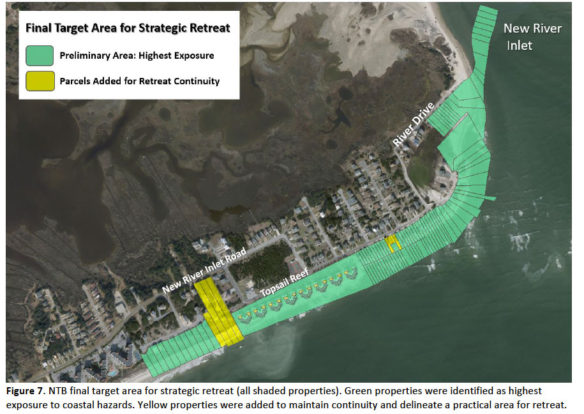
Costs of Targeted Acquisitions at NTB
Capital Costs of Property Acquisition
The estimated capital costs of acquiring the properties in the final target area is $30.1 million. This is the total assessed value of all 347 properties. Since a county re-evaluation was completed in January 2018, assessed property values are a reliable measure of current market value. The average assessed value is approximately $87,000, which may appear low for oceanfront properties. However, 35 of these properties have a value of only $100, because they are either currently inundated by the ocean (32 properties), or classified as a common area or right-of-way (3 properties). In addition, 240 (69%) of the properties are small condos (~ 500 square feet) within the Topsail Reef complex (Figure 7) with an average value of $55,000.
Using current market value is likely a reasonable estimate, as the capital costs of buyouts may be lower if 1) property owners are motivated to sell, 2) damaged properties are purchased after a major storm at a reduced price, and/or 3) an innovative funding approach is used (e.g., paying off the remainder of a property owner’s mortgage). The New Jersey Blue Acres Program reports that buyout properties typically have settlement prices that are below assessed value (Fawn McGee, personal communication).
Lost Tax Revenue
Calculating the potential loss of town and county tax revenue (property, occupancy, and sales tax) is an accurate and meaningful way to quantify the impact of targeted acquisitions to local tax receipts (as opposed to the use of assessed property value). According to the Budget Ordinance for Fiscal Year 2018-2019 (FY19), the tax base of NTB is $955 million (Town of North Topsail Beach, 2018). NTB estimates it will collect about $3.24 million in property tax revenue, $1.7 million in sales tax revenue, and $1.3 million in accommodations tax (Table 3). The total assessed value of all 347 properties in the final target area (Figure 7) is $30.1 million, which represents 3.15% of the NTB tax base. While $30.1 million is a substantial figure, it does not completely reflect the fiscal loss NTB would experience from the removal of these 347 properties. If all 347 target properties are removed from the NTB tax base, the town stands to lose an initial $197,731 in tax revenue; the 30-year loss of this tax revenue is $5.9 million (assuming no property appreciation or inflation). Using a discount rate of 3% and property appreciation rate of 5%, the Net Present Value (NPV) of this loss over 30 years is calculated at $8.1 million (Table 3). It is important to note that the structures on these properties are extremely storm vulnerable, and many could be lost to storms during this period. Therefore, these revenue projections are almost certainly an overestimate as that level of property value appreciation is unlikely. In addition, the improved beach amenity and access at the north end of NTB will almost certainly increase the value of neighboring properties, offsetting some lost revenue.

According to the Onslow County 2018-2019 (FY19) Proposed Budget (Onslow County, 2018), the tax base of the county is $14.2 billion. Onslow County estimates it will collect about $97 million in property tax revenue, $44 million in sales tax revenue, and $1.8 million in accommodations tax (Table 4). The total assessed value of all 347 properties in the final target area represents 0.21% of the county tax base. If all 347 properties are removed from the Onslow County tax base, the county stands to lose an initial $299,486 in tax revenue; the 30-year loss of this tax revenue is $9 million (assuming no property appreciation or inflation). Using a discount rate of 3% and property appreciation rate of 5%, the Net Present Value (NPV) of this loss over 30 years is calculated at $12.3 million (Table 4). Not all properties generate sales and accommodations tax, so this approach overestimates that loss. In addition, not all property owners accepting a buyout will leave Onslow County. Some may choose to invest nearby, offsetting the projected loss in revenue.

With targeted acquisitions of all 347 properties in the final target area, the town of NTB and Onslow County stand to lose combined tax revenue ranging from $14.9 million to $20.4 million over 30 years.
Structure & Sandbag Demolition & Removal Costs
Additional costs of targeted acquisitions include the removal of existing structures and associated infrastructure. The estimated cost of removing all existing structures in the targeted study area is approximately $4 million based on an average demolition cost of $18,000 for a 1,500 square-foot house (Fixr.com, 2019). This amount includes demolition and disposal of 12 single family structures ($0.2 million), 49 duplex structures ($1.8 million) and 8 multi-unit condo structures (Topsail Reefs) containing 240 units ($2 million estimate). The remaining 46 properties in the study area are vacant. In addition, the cost of removing the sandbag revetment (which will no longer be necessary after the properties are acquired and demolished) is estimated at $250,000 based on the cost of removing the geotube as well as the prior revetment maintenance costs. Therefore, the total estimated cost of removing all structures and sandbags from the targeted study area is $4.25 million.
Savings and Benefits of Targeted Acquisitions at NTB
Future Shoreline Stabilization Costs Avoided
According to the 2018 New River Inlet Management Master Plan Engineering and Modeling Report (NRI Master Plan), NTB completed partial construction of Phase 1 of its Shore Protection Project in March 2013 (ATM, 2018). The Phase 1 beach fill episode covered 7,730 feet of shoreline (from station 1163 to station 1090, Figure 8) and involved the emplacement of 600,000 cubic yards of sediment at a cost of $5.6 million. Erosion at the inlet area accelerated in August 2014, resulting in the construction of a 2,000 foot, $2.6 million sand bag revetment at the north end area (Figure 8, Inset).
NTB is proposing to nourish 5,100 feet of shoreline (from station 1163 to station 1115, Figure 8) every two years at a total cost of $58.6 million (using a discount rate of 8% and inflation factor of 4%) over 30 years (ATM, 2018). The proposed acquisition area includes approximately 4,000 feet of shoreline of that proposed project fronting the highest exposure properties (between station 1163 and 1125). Since this segment of shoreline is roughly 80% of the total shoreline length proposed for future nourishment, the resulting 30-year cost in the areas is $47.4 million. This value represents the future beach nourishments costs potentially avoided (over the next 30 years) with the use of a targeted acquisition strategy at NTB.
NTB is considering the construction of a 2,021-foot terminal groin at New River Inlet while nourishing the adjoining 5,100 feet of shoreline for 30 years (Figure 8). The total estimated 30-year cost of constructing and maintaining a terminal groin in conjunction with beach nourishment is $41.4 million ($6 million for groin construction and $35.4 million for beach nourishment every four years) according to the NRI Master Plan (ATM, 2018). Since the final target area is roughly 80% of the total shoreline length proposed for nourishment, the long-term cost of nourishment is $28.3 million. When the cost of groin construction is added, the total 30-year NPV cost of this strategy in the final target area is $34.3 million. If nourishment sand needs to be sourced from further offshore, costs could increase dramatically.
The terminal groin project, if it performs as designed, may present some cost savings in shoreline protection for the target area. At this point, the groin project is just a proposal and permitting is not guaranteed. In addition, the reduction in beach nourishment costs is just an estimate. As sea level continues to rise, the need for more frequent beach nourishment will increase under both scenarios. If the groin project is challenged (which is likely), implementation would not begin for many years. For these reasons, this analysis utilized the nourishment-only option to estimate the costs of protecting the properties in the potential buyout area.
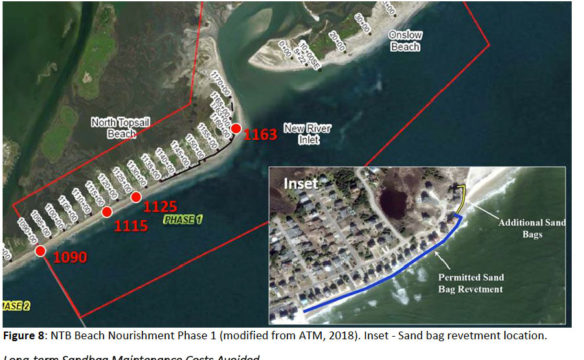
Long-term Sandbag Maintenance Costs Avoided
In 2014, the town of NTB constructed a 2,000 foot, $2.6 million sand bag revetment (Figure 8, Inset). If left in place, this sandbag revetment will require continuous maintenance over the next 30 years. The NRI Master Plan (ATM, 2018) estimates that the sandbag revetment will have annual maintenance costs of between $250,000 and $500,000. Over 30 years, the NPV of avoided maintenance costs ranges from $10.2 million to $20.4 million.
Discussion
Summary of Costs & Benefits
Table 5 is a summary of the estimated, quantifiable costs and benefits of implementing a planned acquisition of the most vulnerable properties at the north end of NTB. It is important to reiterate that the estimated capital costs ($30.1 million) illustrate the “worst case scenario,” since actual capital costs of property acquisition in NTB are likely to be lower. In addition, the estimates of future shoreline stabilization costs using beach nourishment are likely to be low, as these engineering projects often exceed initial estimates, and sea level will rise substantially during the next 30 years. Finally, this analysis does not consider the possibility of cost-sharing. For example, the 30-year cost of beach nourishment to NTB, with state cost-sharing is $7.7 million. Without state cost-sharing, however, the long-term net cost of beach nourishment to NTB increases to $39.3 million. Potential sources of supplemental funding for property acquisition is also not considered, which might include federal agencies and private foundations, as well as increases in local and county tax rates. For example, a one-cent increase in the Onslow County property tax rate (per $100 assessed valuation) will result in a property tax increase of $15.44 for the owner of a median value structure ($154,400 according to the U.S. Census Bureau, 2018), but would generate $58 million over the next 30 years – more than enough to cover the total cost of targeted acquisitions.

The results of the fiscal analysis show the quantifiable long-term costs of strategic acquisitions in NTB are comparable to the savings that would accrue from deferred shoreline stabilization (Table 5). Even if the numbers change slightly, the quantifiable benefits and costs will be similar over the 30-year period analyzed. Most of the properties in the target area are within a CBRS unit. This means that federal funds are not available for shoreline protection and other aspects of infrastructure maintenance and repair. If a source of outside funds could be utilized, or if a local funding mechanism could be implemented, it seems that targeted acquisitions would become very attractive to the citizens of NTB.
Unquantified Benefits
The most compelling reasons for considering a targeted buyout in an area with recurrent coastal hazards are often the most difficult to quantify. For example, a targeted acquisition of highly exposed properties:
• Focuses Municipal Resources on More Sustainable Portions of the Community – Communities dealing with highly exposed properties must invest a significant amount of personnel time, leadership energy, emergency management effort, and money on the maintenance and protection of a relatively small portion of the tax base. A targeted acquisitions plan can allow municipal leadership to focus all resources on the portions of a community that are far more sustainable over the long run. For NTB, this would shift the focus from the 7% to the 93% of the tax base.
• Transfers Amenity Values from Acquired Properties to Remaining Private Properties – In many cases, the values of imminently threatened, oceanfront homes have already begun to decline. When the targeted properties are removed, there will be a new row of properties that will now be “oceanfront.” These new properties will have a significant setback from the shoreline, and a more natural beach fronting them. In many ways, the original oceanfront row of properties may be physically removed, but it is effectively the same as removing the back row. There will still be oceanfront homes; these homes will simply be located at a safer distance from the ocean.
• Increases Recreation Benefits due to Natural Shoreline and Improved Beach Access – Frequently, properties in high hazard areas compromise the beach and beach access. This is true in NTB where the protection of the existing oceanfront properties has effectively eliminated the natural, recreational beach, placing a burden on all those who would utilize that beach. Replacing those properties with a naturally restored beach with improved public access, will provide a natural amenity for everyone in NTB. The value of this improvement is difficult to quantify, but is likely to be substantial.
• Increases Environmental Benefits due to Non-Engineered Beach – Removal of all coastal protection and the structures impinging on the beach will allow the reformation of the natural beach and coastal processes providing higher quality habitat for turtles, shorebirds, and other organisms.
Beach Nourishment
Removing the targeted properties should immediately provide a widened, natural beach. The shoreline will re-equilibrate and return to its natural trajectory. If current erosion rates hold, the buffer between the ocean and development should be adequate for the 30-year period. However, rising sea level will only increase erosion rates and storm impacts in the future. Even with the plans for groin construction and frequent beach nourishment, the properties targeted in this buyout are too vulnerable to be sustainable. The costs to protect these properties, in actuality, will likely be significantly higher than the projected estimates (if it is even possible to protect them).
At the same time, even after the buyout it is likely that some beach nourishment and dune building may be needed to maintain the shoreline (although at significantly reduced frequency and cost). We have not incorporated that cost into this analysis, just as we have not incorporated the accelerating costs of the protection that we believe will be necessary through the current, engineering approach.
Conclusions
We will not be able to hold every U.S. shoreline in place forever. The cost would be prohibitive. We don’t have the sand supply, and doing so would be environmentally problematic. Communities need to begin thinking about how they can focus resources on the most sustainable areas, while developing sensible proposals to reduce the amount of infrastructure in areas of extreme hazard.
This proposal represents a first cut at how one might approach a scientific and fiscal analysis of targeted acquisitions for one such community— North Topsail Beach, North Carolina. The analysis shows that, in this case, the quantifiable benefits outweigh costs over the next 30 years. If outside funds are available for the buyout, then it becomes a very attractive prospect for the municipality; but, it still makes good sense without that support. The savings could be used for dune building, for example. There are many unquantifiable benefits to these targeted acquisitions; however, the real benefit will be a chance to ensure the longer-term economic vitality of the more sustainable portions of the community. This is a way to strengthen North Topsail Beach, not diminish it.









